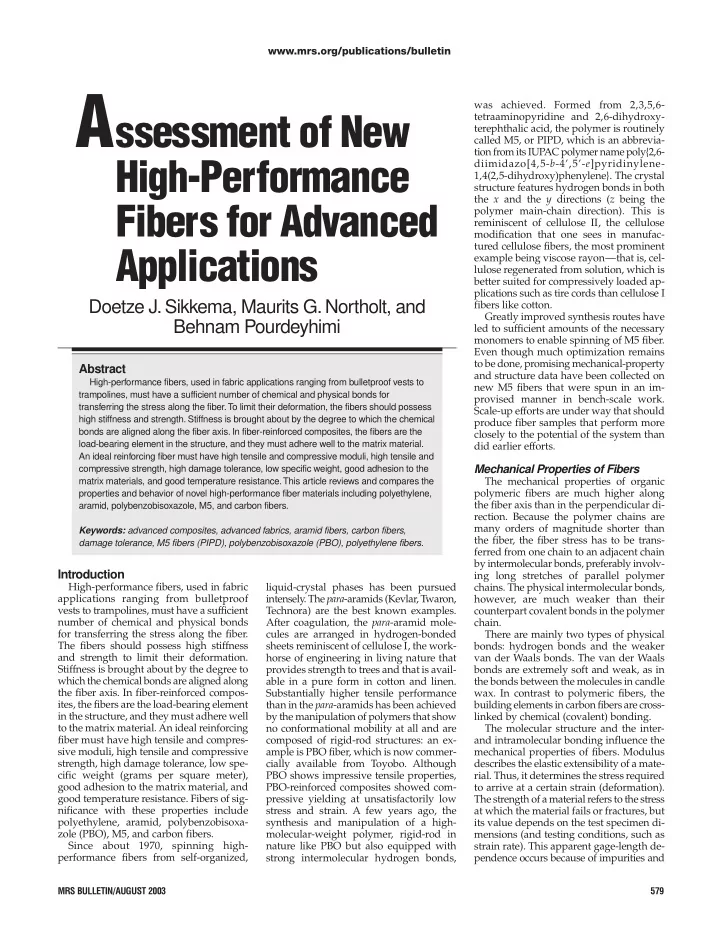

www.mrs.org/publications/bulletin A ssessment of New was achieved. Formed from 2,3,5,6- tetraaminopyridine and 2,6-dihydroxy- terephthalic acid, the polymer is routinely called M5, or PIPD, which is an abbrevia- tion from its IUPAC polymer name poly{2,6- High-Performance diimidazo[4,5- b -4’,5’- e ]pyridinylene- 1,4(2,5-dihydroxy)phenylene}. The crystal structure features hydrogen bonds in both the x and the y directions ( z being the Fibers for Advanced polymer main-chain direction). This is reminiscent of cellulose II, the cellulose modification that one sees in manufac- tured cellulose fibers, the most prominent Applications example being viscose rayon—that is, cel- lulose regenerated from solution, which is better suited for compressively loaded ap- plications such as tire cords than cellulose I Doetze J.Sikkema, Maurits G.Northolt, and fibers like cotton. Greatly improved synthesis routes have Behnam Pourdeyhimi led to sufficient amounts of the necessary monomers to enable spinning of M5 fiber. Even though much optimization remains to be done, promising mechanical-property Abstract and structure data have been collected on High-performance fibers, used in fabric applications ranging from bulletproof vests to new M5 fibers that were spun in an im- trampolines, must have a sufficient number of chemical and physical bonds for provised manner in bench-scale work. transferring the stress along the fiber.To limit their deformation, the fibers should possess Scale-up efforts are under way that should high stiffness and strength. Stiffness is brought about by the degree to which the chemical produce fiber samples that perform more bonds are aligned along the fiber axis. In fiber-reinforced composites, the fibers are the closely to the potential of the system than load-bearing element in the structure, and they must adhere well to the matrix material. did earlier efforts. An ideal reinforcing fiber must have high tensile and compressive moduli, high tensile and Mechanical Properties of Fibers compressive strength, high damage tolerance, low specific weight, good adhesion to the matrix materials, and good temperature resistance.This article reviews and compares the The mechanical properties of organic polymeric fibers are much higher along properties and behavior of novel high-performance fiber materials including polyethylene, the fiber axis than in the perpendicular di- aramid, polybenzobisoxazole, M5, and carbon fibers. rection. Because the polymer chains are many orders of magnitude shorter than Keywords: advanced composites, advanced fabrics, aramid fibers, carbon fibers, the fiber, the fiber stress has to be trans- damage tolerance, M5 fibers (PIPD), polybenzobisoxazole (PBO), polyethylene fibers. ferred from one chain to an adjacent chain by intermolecular bonds, preferably involv- Introduction ing long stretches of parallel polymer High-performance fibers, used in fabric liquid-crystal phases has been pursued chains. The physical intermolecular bonds, applications ranging from bulletproof intensely. The para -aramids (Kevlar, Twaron, however, are much weaker than their vests to trampolines, must have a sufficient Technora) are the best known examples. counterpart covalent bonds in the polymer number of chemical and physical bonds After coagulation, the para -aramid mole- chain. for transferring the stress along the fiber. cules are arranged in hydrogen-bonded There are mainly two types of physical The fibers should possess high stiffness sheets reminiscent of cellulose I, the work- bonds: hydrogen bonds and the weaker and strength to limit their deformation. horse of engineering in living nature that van der Waals bonds. The van der Waals Stiffness is brought about by the degree to provides strength to trees and that is avail- bonds are extremely soft and weak, as in which the chemical bonds are aligned along able in a pure form in cotton and linen. the bonds between the molecules in candle the fiber axis. In fiber-reinforced compos- Substantially higher tensile performance wax. In contrast to polymeric fibers, the ites, the fibers are the load-bearing element than in the para -aramids has been achieved building elements in carbon fibers are cross- in the structure, and they must adhere well by the manipulation of polymers that show linked by chemical (covalent) bonding. to the matrix material. An ideal reinforcing no conformational mobility at all and are The molecular structure and the inter- fiber must have high tensile and compres- composed of rigid-rod structures: an ex- and intramolecular bonding influence the sive moduli, high tensile and compressive ample is PBO fiber, which is now commer- mechanical properties of fibers. Modulus strength, high damage tolerance, low spe- cially available from Toyobo. Although describes the elastic extensibility of a mate- cific weight (grams per square meter), PBO shows impressive tensile properties, rial. Thus, it determines the stress required good adhesion to the matrix material, and PBO-reinforced composites showed com- to arrive at a certain strain (deformation). good temperature resistance. Fibers of sig- pressive yielding at unsatisfactorily low The strength of a material refers to the stress nificance with these properties include stress and strain. A few years ago, the at which the material fails or fractures, but polyethylene, aramid, polybenzobisoxa- synthesis and manipulation of a high- its value depends on the test specimen di- zole (PBO), M5, and carbon fibers. molecular-weight polymer, rigid-rod in mensions (and testing conditions, such as Since about 1970, spinning high- nature like PBO but also equipped with strain rate). This apparent gage-length de- performance fibers from self-organized, strong intermolecular hydrogen bonds, pendence occurs because of impurities and MRS BULLETIN/AUGUST 2003 579
Recommend
More recommend